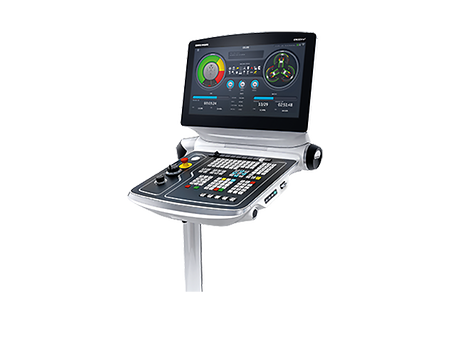


Directed Energy Deposition through Powder Nozzle
LASERTEC DED: Additive Manufacturing by powder nozzle
- From the pure laser application machine to universal hybrid solutions
- Multi-material deposition and multi-axis machining
- Process monitoring and adaptive process control
- Complete CAD/CAM process chain
- CELOS: The App-based control and operating system
- Exclusive DMG MORI technology cycles available
- ERGOline 21.5" Multi Touch Panel mit CELOS und SIEMENS SINUMERIK 840 D sl
Pinpoint material deposition using a powder nozzle
During laser metal deposition, also known as directed energy deposition (DED), material is deposited using a powder nozzle. The metal powder is thus blown into the laser, which fuses it to the surface of a metal with pinpoint accuracy. The process is characterised by a very high build-up rate. The layered 3D printing of the component can be performed using one or multiple materials. In the case of multi-material applications, different metals are applied in rotation, which give the component the desired properties, such as greater thermal conductivity or different levels of hardness in certain areas.
Economic maintenance thanks to laser metal deposition
The DED process also enables the repair or coating of existing components. This now concerns up to 50 percent of applications. The powder nozzle can deposit onto any material surface. This makes an entire range of applications possible, such as restoring worn tool moulds to their original quality. In many cases the method is less expensive than producing a new spare part following wear. The process is also faster, meaning that users can maximise the availability of their systems.
Hybrid concept for additive workpieces, with the same quality as precast units
In the majority of applications involving material build-up by means of laser metal deposition, post-processing steps using milling machines or lathes are required. Hybrid concepts, such as the LASERTEC DED hybrid series from DMG MORI, represent an economical alternative. In a single workspace, they combine laser metal deposition using a powder nozzle with conventional milling or milling/turning. Flexible changing between additive and chipping production enables the direct processing of component segments and the integration of the entire production chain into one machine. When performing laser metal deposition, users also benefit from 5-axis or 6-sided complete machining, as made possible by modern milling machines and milling/turning centres. An approach like this enables efficient finishing within the µm range – in places that otherwise may not have been accessible following the complete building up of the component. As such, even the most complex of geometries can be realised with the same quality as precast units.
Product range, up to XXL machining
The portfolio of hybrid machines ranges from the LASERTEC 65 DED hybrid to the LASERTEC 6600 DED hybrid. It is based on a turning/milling centre and offers travel distances of 1,040 x 610 x 3,890 mm.
Laser metal deposition: a quick summary
What is laser deposition welding?
Laser deposition welding, or directed energy deposition, uses a powder nozzle through which a metal powder is blown into the laser. It is thus possible to fuse the metal onto a surface with pinpoint accuracy. Because the powder used in this process can be changed, different materials can be used to give the components special properties.
Which materials can be used for selective laser deposition welding?
There is a wide range of metal powders that can be used for laser deposition welding. Steels such as Inconel can be used, as can copper-bearing coloured alloys.
What advantages do hybrid machines offer?
Hybrid machines combine laser deposition welding and conventional machining in one workspace. This way, workpieces can be manufactured in finished part quality, without re-working on other machines. This applies in particular for complex geometries, as the hybrid concept means even points that would no longer be accessible following subsequent deposition can be milled. Another advantage of hybrid machining is that processing time is reduced by up to 80 percent, especially in case of repair. Process integration does away with the need for a labour-intensive set-up process for the post-processing steps (hardening, milling, grinding, measuring...).





